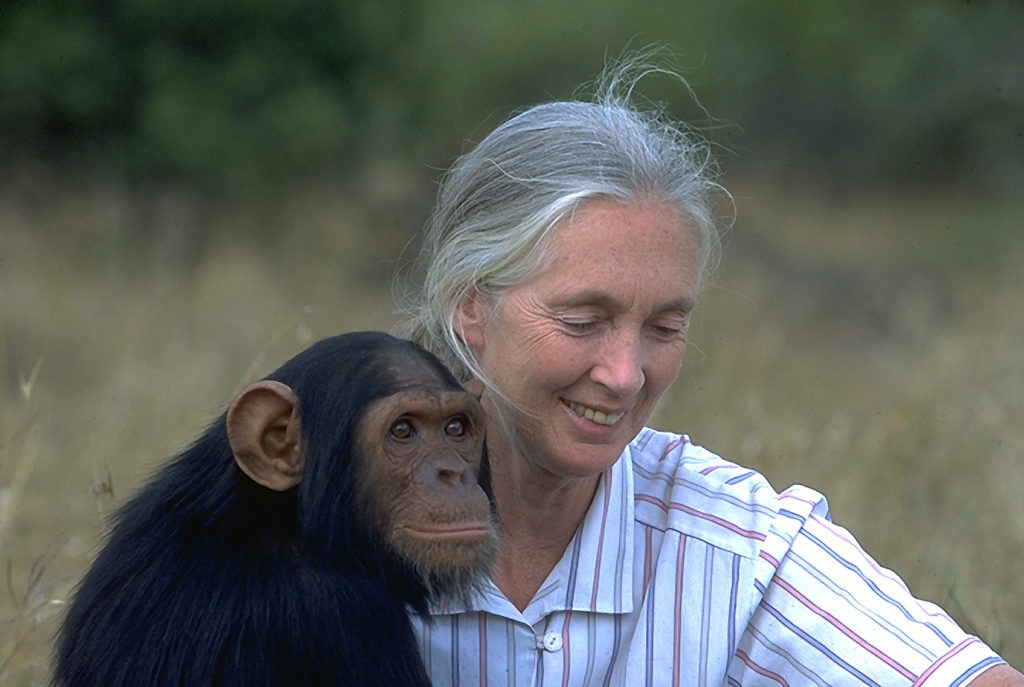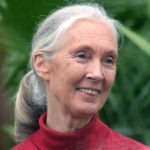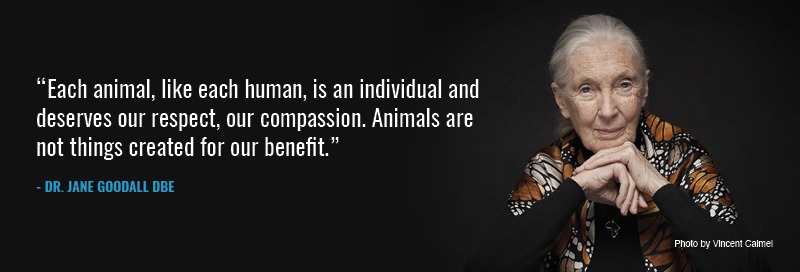In this exclusive interview, world-renowned animal advocate and Voiceless patron Dr. Jane Goodall DBE shares her inspiring story about how she became a driving force for positive change for animals around the world.
What was your “a-ha” moment or moments in forming your thinking that animals are important and worthy of our ethical and moral consideration?
Quite honestly, I was born with a fascination for animals. My mother came to my room to say goodnight once when I was 1 ½ years old and found my bed full of earth and earthworms. She said I was watching them so intently – she thought perhaps I wondered how they moved without legs! Her support of my love for animals was really important – she did not get angry, but simply said they would die if we did not return them to the garden. I agreed, but cried a bit apparently!
To those who may feel that animal protection/rights is a trivial or fringe issue when there are so many “human problems” in the world, what would you say to the question, why do animals matter?
First of all, I want to point out that we humans are animals too. We are part of and not separate from the natural world on which we rely for food, water, clothing and air. People matter too. In 1990 I flew over the tiny Gombe national park and, looking down, I realized that the village communities around Gombe were struggling to survive, too many people for the land to support, overused infertile farmland, no money for buying food from elsewhere, cutting down the last trees in their desperation to grow more food, or make charcoal as a means of livelihood. And it was then that it hit me – we cannot save the chimpanzees and their forests unless we help the people find ways of living that do not involve destroying their environment. So the Jane Goodall Institute (JGI) launched Tacare (Ta(ke)care), our holistic method of community-based conservation. In this way, we could improve the lives of people whilst helping wildlife. This program now includes 104 villages throughout the chimpanzees’ range in Tanzania, and is growing in six other countries around chimpanzee habitat. The villagers realize that saving the environment is not only to benefit animals but also to safeguard their own future. For forests provide clean air, clean water, and help to prevent erosion and control temperature and rainfall.
But should we only be concerned to save the environment and the amazing species of plants, trees and animals that make up the complex web of life only because we humans depend on mother nature for our own survival? Should we not wish to save it for its own sake? We have been so arrogant. At Cambridge University in the early 1960s, I was told that there was a difference in kind between us and other animals. I should not have given the chimpanzees names, but numbers. I could not talk about their vivid personalities, their minds capable of solving problems, their emotions so similar to those we call happiness, sadness, depression, anger, frustration, grief and so on, because those qualities were unique to us humans.
Fortunately, I had a wonderful teacher as a child who had taught me that in this respect the professors were wrong. That teacher was my dog, Rusty! You cannot share your life in a meaningful way with any animals such as a dog, cat, rabbit, bird, rat, pig, horse and so many more and not know that we are not the only sentient and sapient beings on the planet. Each animal, like each human, has a role to play in the scheme of things.
Why did you choose to get involved in speaking up for animals? What drives your passion for advocating for animals?
I see animals as individuals. I understand that they have emotions similar to our own. That they feel pain. When I see animals, still alive, crammed into tiny cages in the meat markets of Africa and China, when I see secretly filmed video of conditions in the factory farms where billions of animals are raised each year for human consumption – and for pet food – I am horribly disturbed. And seeing the thoughtless way some people treat their pets I am saddened. Knowing about the testing on animals in medical and pharmaceutical research laboratories, what they must endure and the way they are typically treated fills me with anger. Of course, some people are, by nature (or nurture perhaps – actually it would be lack of nurture!) truly sadistic, truly enjoy inflicting pain. But surely most people, if they understood the true nature of animals would not treat them so cruelly? I have been so fortunate in my life, brought up by a wise mother in a family that loved animals and spending years studying one of the most fascinating of beings, the chimpanzees, that I feel that it is my job to teach people, especially children, to understand the true nature of animals.
How do your professional life and interest in the treatment of animals intersect?
Animals have always been a part of my life since I was a very young child. When I finally went to Cambridge University to get a degree in ethology I was taught to think and write in a scientific way, but I would not compromise my knowledge, gained from experience and intuition, and agree to fall in with the accepted scientific thinking of the time. But I did learn to think and write in a logical scientific way. And I realised that while scientists were telling me that it was not appropriate to show empathy towards the animals being studied, empathy in fact is a great tool to help us understand, if used wisely. “Aha” you think to yourself as intuitively you feel you know why an animal behaved in such and such a way. And then you can examine the behaviour and use scientific methods to test if you are right.
Once I had my PhD I was in a better position to discuss animal welfare with other scientists. And it gave me the confidence to go into the medical research labs and talk about the inappropriateness of many ways in which the animals were treated, to write letters to legislators recommending change, and to speak to people around the globe about compassion and respect for the other life forms on our planet. And by presenting my views based on my own experiences, in storytelling form but based on facts and not just emotion, I was more likely to get people to listen.
Currently, there is little to no animal protection or humane education in classrooms. Do you believe humane education is important in school education? And if so, why?
I believe that humane education is extremely important… Once children understand that animals have feelings much like themselves they are more likely to be kind to them. I saw three little boys throwing stones at a dog in Tanzania. And laughing as it yelped in pain. I went over to them and spoke to the obvious ringleader, a child of about 7. “Why are you doing this?” I asked. The boy shrugged his shoulders. “Would you like it if a stone hit you?” I asked. “No” he admitted. “What would you do? Would you cry out?” He nodded. “Would it hurt?” He nodded again. “Why does the dog cry out? Don’t you think that’s because he feels pain too?” I don’t know if it did any good, but he looked a bit sorry. It has been found that children with a history of cruelty to animals tend to become abusive to humans when they get older. The earlier we can teach children that animals have feelings of fear and pain and sadness similar to ours the more likely it is that they will be kind.
There are programs in which animals are taken into the classroom so children can see them close up, touch them perhaps. Stroking a kitten or a rabbit can give a child a warm feeling. Something like love. There are some amazing stories and videos of animals helping each other and helping humans. And of animals demonstrating intelligent behaviour, chimpanzees, gorillas and orangutans who have learned sign language, crows making tools to solve problems. There are 5 rats (Paris, Shadow, Raven, Suki and Famous) who have been taught to do the most amazing tricks. There are some great apes who love to paint. And there is a pig (Pigcasso), a rhino (Mechi) and a couple of horses (Metro Meteor is my favorite) and dogs who also paint. Watching these videos inspires respect for the animals. And they incite curiosity. And not only in children – people to whom I show Pigcasso have said “I hate you – I can never eat bacon again”!!!. Which is why I show it, of course! [people can find all these on the internet. Google Pigcasso and choose the Geographic version (it’s the best); Mechi the painting rhino; Five smart rats (ignore 5 ways to kill smart rats!!)
What do you think is the biggest injustice to animals and how can we stop it?
Raising them in factory farms that are truly concentration camps for animals – for us or our dogs or cats to eat. They are usually treated with absolute brutality, thought of as meat on legs and not as individuals who suffer. Regarded as ‘things’ and not as individuals. Denied respect. These farms remind one of the Nazi death camps as vividly described by Charles Patterson in Eternal Treblinka: Our Treatment of Animals and the Holocaust. It is when people are thought of as ‘merely animals’ that the horrors of slavery, genocide, torture and the holocaust become possible. The German Jewish philosopher, Theodor Adorno, said “Auschwitz begins wherever someone looks at a slaughterhouse and thinks: they’re only animals.” Understanding the true nature of animals would discourage that way of thinking.
Factory farming is cruel, and it encourages those who work there to become callous and hardened – those who don’t tend to become depressed, suicidal – or quit. To end this horrific cruelty we must somehow diminish the demand for meat. Education is key. And this means not only helping people to understand the true nature of animals, but also the tremendous harm meat-eating can do to the environment, and its major effect on climate change. Billions of animals to be fed, land cleared to grow the grain to feed them, large amounts of water (which is increasingly in short supply in some parts of the world), fossil fuel burned to get grain to animals, to abattoirs, meat to table.
Moreover, while most people understand that the massive amount of CO2 that is released into the atmosphere by our reckless burning of fossil fuel is largely responsible for the so-called ‘greenhouse gases’ (that form a blanket around Earth and trap the heat of the sun), fewer realise that methane is another virulent greenhouse gas – and a large percentage of it comes from the gas created by animals during digestion. [I guess we cannot call it farting!!!!!] As well, animal waste often makes its way, during floods or heavy rain, into rivers and adds to the pollution of the ocean. Feeding the animal victims antibiotics just to keep them alive in their terrible conditions means that more and more bacteria become resistant leading to ‘superbugs’ that defy treatment and lead to human deaths.
There is now growing awareness that meat production drives climate change, causes environmental destruction, and harms human health. We see an increase in veganism and vegetarianism, and a new industry of plant-based and bioengineered alternative proteins. But on the other hand, there is a huge increase in factory farming in economies such as China, and demand for meat is growing globally. What are your thoughts on where these conflicting trends are taking us in the next decades?
Education is key here - Most people honestly do not understand the facts. It is very important that we somehow persuade governments to close down factory farms and encourage farmers, with subsidies, to move to a more environmentally friendly way of making a living.
Again, education is the answer, at least in part. How many people understand the true conditions in which their pork, bacon, lamb, chicken etc was raised? How many even think about the animals it once was? How many know their gut is not designed to eat a lot of meat? How many think, as I once did when I learned about factory farms, about the symbolism of a piece of meat on our plate: “This symbolizes Fear; Pain; Death”.

What is your vision of the future of humans’ relationships with animals and do you have thoughts or ideas on how we can get there?
The most important issue here is that we understand that animals are sentient, that they are not things but individuals each with a personality. That many have emotions of joy, sadness, anger, frustration, grief and can show compassion and empathy towards each other - and towards us. It is not necessary to ‘love’ them, but to understand they have as much right to their lives as we do to ours. We need to understand the role they play in the ecosystem and stop all use of pesticides, herbicides, poison baits, and so on. Any animals in captivity – sanctuaries, zoos, pets – must be treated with understanding and respect. How do we get there? Again, education that helps people to understand the true nature of animals, and all they do for us. That helps us understand the fact that heavy meat-eating comes not only as a result of horrendous cruelty and environmental damage, but that it is a main cause of climate change? “Only if we understand can we care. Only if we care shall we help. Only if we help shall all be saved”.
What would a future world where animals are treated with respect and compassion look like in practical, day to day terms, and how would it look different to today’s world?
Much of my vision of an ideal world is hardly practical unless we undergo a sea change in our thinking, and solve some major problems! But here goes – some aspects of Dr. Jane’s ideal world.
All factory farms are things of the past. Some cultures rely on livestock because of the arid environments – and animals can turn grass into more nutritious protein. But those that are eaten in my ideal world are free-ranging. I hate the thought of a world without cows and goats and hens and so on, so some are living out their lives in suitable protected areas. Plant-based foods and drinks are delicious and affordable. There is no ‘bushmeat trade’, no breeding and eating of wild animals… no leg hold traps, snares and so on. The very idea of trophy hunting causes horror – “did people really do that?” Predators have been reintroduced to all suitable habitats so that ecosystems are once again in balance. And green corridors link protected areas.
Overpopulation of some species (such as stray and feral dogs and cats, huge increase of rat populations in cities etc) is prevented by new and innovative ways of birth control. Human/animal conflict has been minimised through education and by innovative ways of preventing crop-raiding – such as beehive fences around crops to scare off elephants, inedible crops surrounding protected areas. People pay large fines for feeding bears, monkeys etc. There are wonderful new technologies that prevent road kills; birds flying into power lines, tall buildings, wind turbines and so on; strikes by ships on marine mammals.
The biodiversity of the oceans has been restored – no overfishing, deep-sea dredging, drift nets, long lines etc. The plastic waste has been removed from the ocean, single-use plastic is banned in all countries. There are no animals of any sort used in product testing, and medical research now relies on much more efficient techniques than using animals. No wild animals are pets, and there is no pet ownership unless owners can prove they are able to provide adequate conditions – dogs are never shut in all day, rabbits, guinea pigs and so on never unduly confined. The extractive industries, the building of dams and more and more shopping malls etc are not allowed where this destroys the environment. New developments are not permitted if this would harm the environment. And everyone will have access to affordable clean energy.
Of course, in order for such a world to become reality four major problems will have to be solved: poverty, unsustainable lifestyles, corruption, and human population growth.
“Dream on” you say. “Dream on”. Nevertheless, such a world would be possible if everyone cared, used their brains and allowed compassion into their hearts.

Dr. Jane Goodall DBE is the Founder of the Jane Goodall Institute, an organisation dedicated to advancing the vision and work of Dr. Jane Goodall through conservation efforts to protect animals and conserve the natural world, in turn improving the lives of people, animals and the environment. Through Dr. Jane Goodall’s holistic approach of nine strategies such as conservation science, advocacy and the protection of chimpanzees and other apes, the Jane Goodall Institute brings the power of community-centred conservation to life.
Disclaimer: Opinions expressed by guest authors and interviewees are those of the relevant contributors and may not necessarily represent the views of Voiceless. Read full terms and conditions here.


